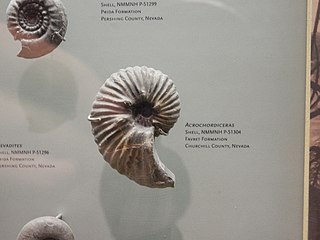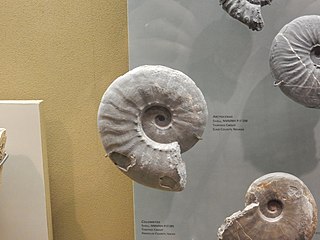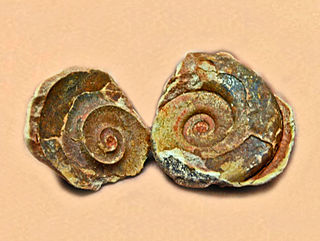
Acrochordiceras is a genus of Middle Triassic ammonoid cephalopods belonging to the ceratitid family Acrochordiceratidae, included in the superfamily Ceratitoidea.
Anatropites is a genus of ammonite in the ceratitid family Tropitidae with spines instead of nodes on the umbilical shoulder, at least in early whorls. Ceratitids are mostly Triassic ammonoid cephalopods.
Arthaberites is a genus of ceratitid cephalopods included in the Noritidae that lived during the Middle Triassic, found in the Alps and Balkans of Europe. Its type is A. alexandrae.
Anderssonoceras is a genus of small, smooth ammonites with a flared umbilical shoulder, like Prototoceras, assigned to the ceratitid family Anderssonoceratidae as the type, but once included in the Otoceratidae.
Anotoceras is a genus of smooth shelled, discoidal ammonites with a depressed, subtrigonal whorl section and ceratitic sutures included in the ceratitid family Otoceratidae.

Arctoceras is a genus of ceratitid ammonoids from the Lower Triassic with a moderately narrow discoidal shell and ceratitic suture.
Arctogymnites is a genus of ammonoid cephalopods from the middle Triassic included in the ceratitid subfamily Beyrichitinae. Related genera include Beyrichites, Frechites, Gymnotoceras, and Salterites
Arctohungarites is a genus of Triassic ammonoids now placed in the ceratitid family Danubitidae, but previously included in the Hungeritidae.

Xenodiscoidea, formerly Xenodiscaceae, is a superfamily within the ammonoid order Ceratitida. The superfamily was named by Frech in 1902, presently contains ten families, only one of which was included in the original Otocerataceae of Hyatt, 1900, the remaining having been added.
Ceratitoidea, formerly Ceratitaceae, is an ammonite superfamily in order Ceratitida characterized in general by highly ornamented or tuberculate shells with ceratitic sutures that may become goniatitic or ammonitic in some offshoots.
Sirenites is a genus of ammonoid cephalopods from the Upper Triassic included in the Ceratitida, and type for the trachyceratid subfamily Sirenitinae.
Pseudosirenites is a genus of Upper Triassic ammonites belonging to the ceratitid family Trachyceratidae, like Sirenites, but with a narrow outer rim (venter) that has a nodose keel on either side.
Vredenburgites is a genus of ceratitids in the family Trachyceratidae. Its shell has numerous, thin, flexious ribs.
Aplococeratidae is a family of ceratitids from the Middle Triassic with very simplified sutures and a tendency to lose their ornamentation. Shells are generally evolute, more or less compressed, with rounded venters. Ornamentation if present consists of umbilical ribs that disappear outwardly, toward the venter. The suture is ceratitic or goniatitic.
Inyoites is an ammonoid genus from the Lower Triassic, included in the ceratitid family Inyoitidae.
Dagnoceras is a ceratitid ammonite from the Lower Triassic that has a basically evolutute, discoidal shell with an arched venter and ceratitic sutures. The Treatise 1957 includes it in the Meekoceratidae although it has since been placed in the Dinaritidae.
Dieneria is a genus of ceratitid ammonoid cephalopods from the Late Triassic of western North America with a smooth discoidal shall of which the venter is truncate and the suture simple. Only the first lateral lobe is slightly serrated, the other lobes entire (smooth)
Olenekoceras is an ammonoid cephalopod from the Lower Triassic included in the ceratitid family Sibiritidae, once included in the Noritaceae but now in the Ceratitaceae.

Ophiceras is a genus of smooth, evolute ceratitid ammonites from the Early Triassic, with a rounded venter. Fossils of the genus have been found in Armenia, Azerbaijan, China, Greenland, and India.

Meekoceras is a genus of ceratitid ammonites with a discoidal shell that lived during the Early Triassic Epoch.




